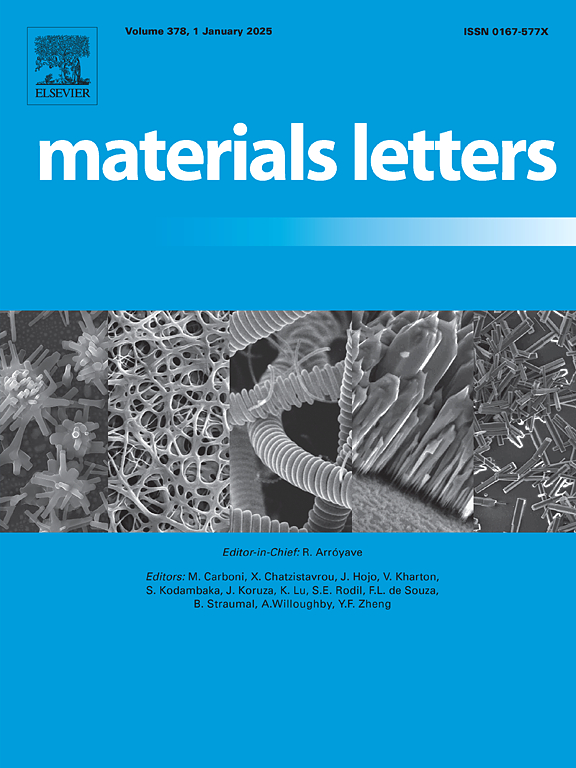Superior compressive performance of CoCrNi-TiC octet plate-lattices metamaterials
IF 2.7
4区 材料科学
Q3 MATERIALS SCIENCE, MULTIDISCIPLINARY
引用次数: 0
Abstract
High/Medium-entropy alloys with exceptional mechanical properties have recently emerged as advanced solutions for the design of new metamaterials. However, medium-entropy alloy (MEA), especially CoCrNi, doesn’t have the desirable yield strength. In order to address this issue, the nano-TiC particles were utilized as reinforcement agents to enhance the mechanical performance of CoCrNi-based alloy metamaterials in this work. Compressive performance of the proposed metamaterial was investigated through experimental and numerical simulation methods. The experimental findings indicate that the incorporation of TiC significantly improves the mechanical properties of CoCrNi-based octet-plate metamaterials, Specifically, the strength and energy absorption of metamaterials with 3% TiC increase by 60% and 25%, respectively, compared to those of CoCrNi metamaterials. The failure mechanism exhibits an ideal layer-by-layer collapse mode, accompanied by localized buckling instabilities. Numerical results show that, as the fraction of TiC increases from 0% to 5%, the strength and energy absorption of metamaterials increase by 108% and 118%, respectively. Furthermore, comparing with the additively manufactured metamaterials with octet-plate/truss unit cells, CoCrNi-TiC metamaterials exhibit superior mechanical properties at the same relative density.
CoCrNi-TiC八晶板晶格超材料优异的抗压性能
具有优异机械性能的高/中熵合金最近成为设计新型超材料的先进解决方案。然而,中熵合金(MEA),尤其是CoCrNi,却没有理想的屈服强度。为了解决这一问题,本研究利用纳米tic颗粒作为增强剂来增强cocrni基合金超材料的力学性能。通过实验和数值模拟方法研究了该超材料的压缩性能。实验结果表明,TiC的掺入显著提高了CoCrNi基八元板超材料的力学性能,其中,与CoCrNi超材料相比,TiC含量为3%的超材料强度和吸能分别提高了60%和25%。破坏机制表现为理想的逐层破坏模式,并伴有局部屈曲失稳。数值结果表明,当TiC含量从0%增加到5%时,超材料的强度和吸能分别提高108%和118%。此外,在相同的相对密度下,CoCrNi-TiC超材料的力学性能优于具有八极板/桁架单元胞的增材制造超材料。
本文章由计算机程序翻译,如有差异,请以英文原文为准。
求助全文
约1分钟内获得全文
求助全文
来源期刊

Materials Letters
工程技术-材料科学:综合
CiteScore
5.60
自引率
3.30%
发文量
1948
审稿时长
50 days
期刊介绍:
Materials Letters has an open access mirror journal Materials Letters: X, sharing the same aims and scope, editorial team, submission system and rigorous peer review.
Materials Letters is dedicated to publishing novel, cutting edge reports of broad interest to the materials community. The journal provides a forum for materials scientists and engineers, physicists, and chemists to rapidly communicate on the most important topics in the field of materials.
Contributions include, but are not limited to, a variety of topics such as:
• Materials - Metals and alloys, amorphous solids, ceramics, composites, polymers, semiconductors
• Applications - Structural, opto-electronic, magnetic, medical, MEMS, sensors, smart
• Characterization - Analytical, microscopy, scanning probes, nanoscopic, optical, electrical, magnetic, acoustic, spectroscopic, diffraction
• Novel Materials - Micro and nanostructures (nanowires, nanotubes, nanoparticles), nanocomposites, thin films, superlattices, quantum dots.
• Processing - Crystal growth, thin film processing, sol-gel processing, mechanical processing, assembly, nanocrystalline processing.
• Properties - Mechanical, magnetic, optical, electrical, ferroelectric, thermal, interfacial, transport, thermodynamic
• Synthesis - Quenching, solid state, solidification, solution synthesis, vapor deposition, high pressure, explosive
 求助内容:
求助内容: 应助结果提醒方式:
应助结果提醒方式:


